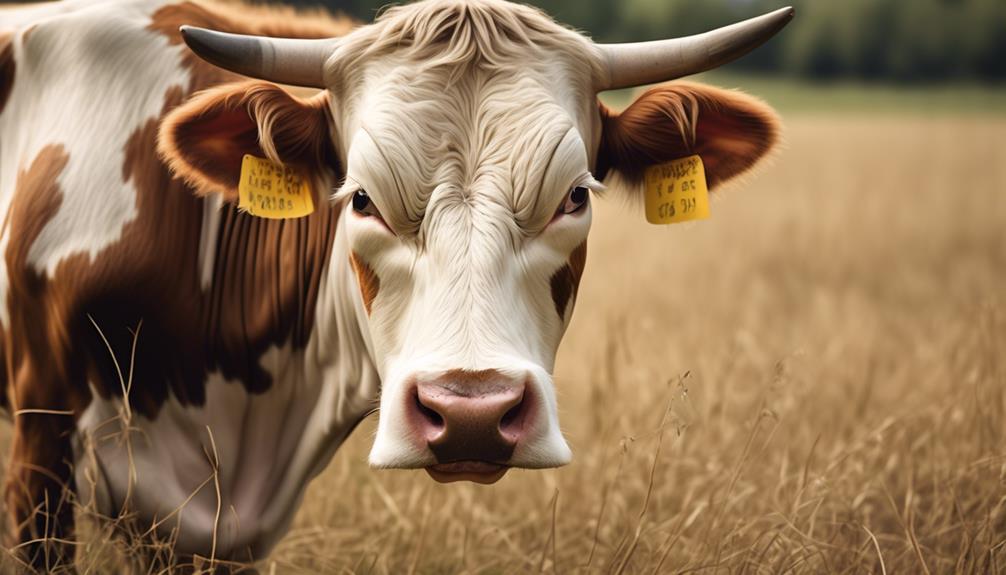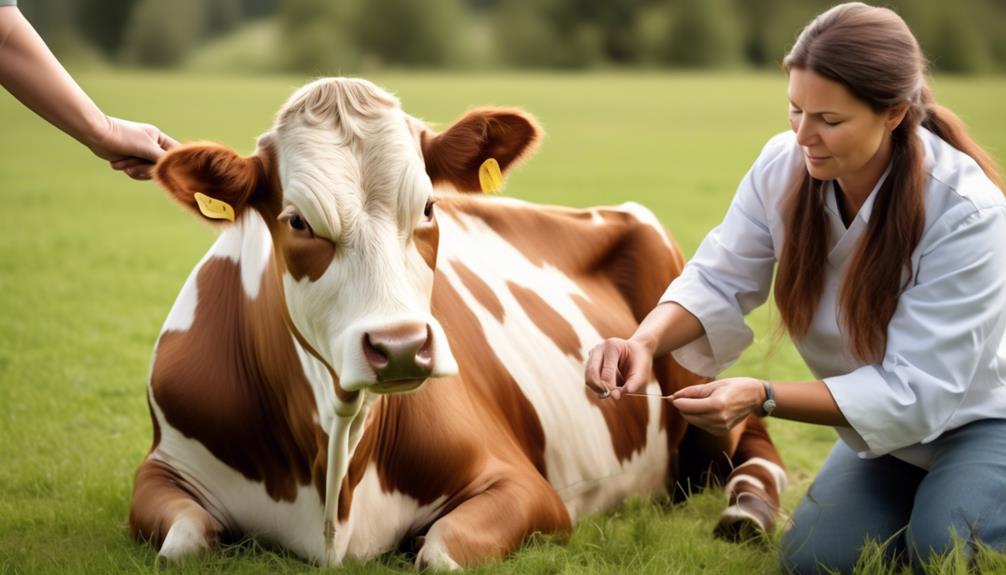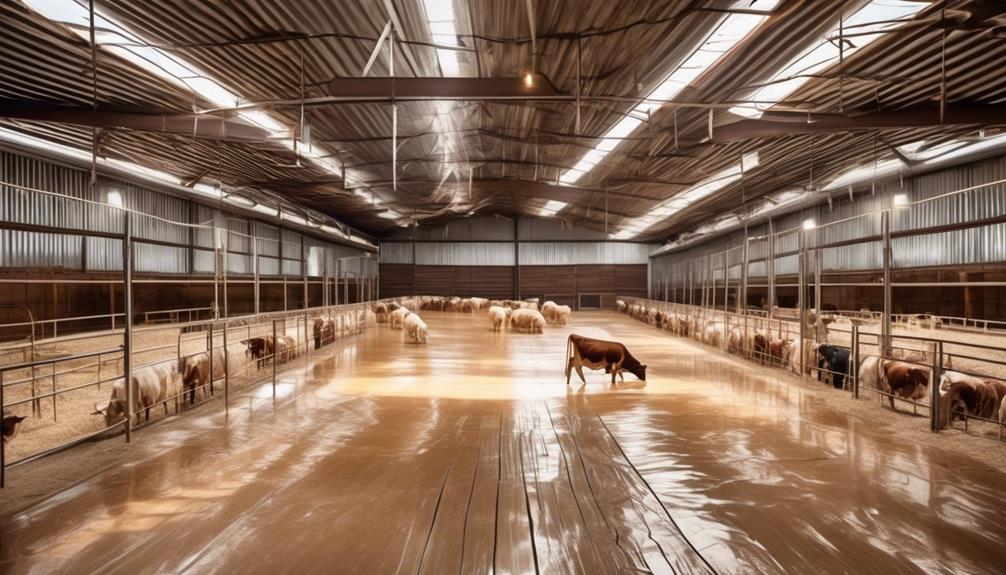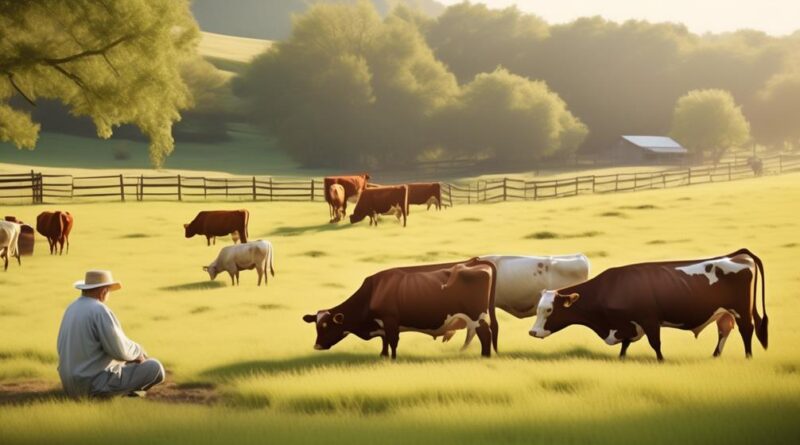Maintaining Comfort for Aging Cattle: Pain Management Guide
As cattle age, they provide a sense of comfort and stability in your herd, but they also face the challenges of aging and potential pain. Understanding how to maintain their comfort and manage any pain they may experience is essential for their well-being.
In this guide, you will explore various techniques and options for pain management that can help ensure the continued comfort and health of your aging cattle.
From pharmaceutical interventions to alternative methods and long-term strategies, you'll gain valuable insights into providing the best care for your aging cattle.
Understanding Cattle Pain

Understanding cattle pain is crucial for effective pain management in aging cattle. Cattle behavior is a key factor in recognizing pain. Observing changes in their normal behavior, such as decreased social interaction, altered feeding habits, or increased restlessness, can indicate discomfort. It's important to understand that pain perception in cattle is similar to humans. They experience both acute and chronic pain, and it can significantly impact their overall well-being.
When it comes to cattle behavior, it's essential to pay attention to subtle cues. For instance, a normally social animal that becomes isolated or a typically active animal that becomes lethargic may be experiencing pain. Additionally, changes in feeding behavior, such as reduced feed intake or changes in chewing patterns, can be indicative of discomfort. This understanding of cattle behavior provides valuable insights into their pain perception.
Pain perception in cattle is a complex process involving physiological and psychological factors. It's vital to recognize that cattle, like humans, experience pain differently based on various factors such as age, health status, and individual differences. Acknowledging these differences is critical for tailoring effective pain management strategies for aging cattle.
Common Pain Symptoms
Recognizing common pain symptoms in aging cattle is essential for timely intervention and effective pain management. It's crucial to be attentive to signs that may indicate discomfort or pain in your cattle. Here are some common pain symptoms to look out for:
- Changes in Behavior: Keep an eye out for alterations in your cattle's behavior, such as increased aggression, restlessness, or a sudden reluctance to move. These changes could indicate discomfort or pain.
- Decreased Feed Intake: A noticeable decrease in appetite or a reluctance to eat may signify underlying pain or discomfort in aging cattle. Monitoring their feed intake can provide valuable insights into their well-being.
- Lameness or Gait Abnormalities: Any signs of lameness or difficulty in walking shouldn't be overlooked. Observing your cattle's gait and movement can help identify pain related to musculoskeletal issues.
When these pain symptoms are identified, it's crucial to consider appropriate treatment options. Consult with a veterinarian to determine the best course of action for managing pain in aging cattle. The treatment options may include pain medication, supportive care, changes in management practices, or other interventions tailored to address the specific cause of pain.
Early recognition of these signs and proactive intervention can significantly contribute to the comfort and well-being of aging cattle.
Pain Assessment Techniques

To effectively assess pain in aging cattle, veterinarians employ various techniques to accurately gauge the level of discomfort and determine appropriate management strategies. Behavioral indicators play a crucial role in pain assessment. Observing changes in behavior such as restlessness, decreased feed intake, isolation from the herd, and abnormal vocalization can provide valuable insights into the animal's discomfort. Additionally, alterations in normal activities like lying down and rising, grooming, and response to human interaction can also indicate pain.
Furthermore, physical examination is another essential component of pain assessment in aging cattle. Veterinarians perform thorough examinations to identify signs of discomfort such as lameness, swelling, changes in posture, and alterations in gait. In addition, palpation of specific body areas can reveal localized pain responses, aiding in the localization and characterization of the pain.
Incorporating both behavioral indicators and physical examination allows for a comprehensive and accurate assessment of pain in aging cattle. By carefully considering these techniques, veterinarians can form a more complete understanding of the animal's discomfort and tailor appropriate pain management strategies.
This holistic approach ensures that the unique needs of aging cattle are met, ultimately promoting their well-being and comfort.
Pharmaceutical Pain Relief Options
After evaluating behavioral indicators and conducting a thorough physical examination to assess pain in aging cattle, the next step is to explore pharmaceutical pain relief options. When it comes to managing pain in aging cattle, there are several pharmaceutical pain relief options available to alleviate discomfort and improve their overall well-being.
Here are some analgesic options and pain medications commonly used for aging cattle:
- Non-Steroidal Anti-Inflammatory Drugs (NSAIDs): NSAIDs are commonly used to reduce pain and inflammation in aging cattle. These medications work by inhibiting the production of prostaglandins, which are responsible for pain and inflammation. NSAIDs can provide effective relief for conditions such as arthritis, lameness, and post-operative pain in aging cattle.
- Opioids: Opioid medications, such as morphine and butorphanol, are potent pain relievers that can be used in aging cattle for severe or chronic pain management. These medications work by binding to opioid receptors in the central nervous system, modulating pain perception, and providing relief for moderate to severe discomfort.
- Local Anesthetics: Local anesthetics, such as lidocaine, can be used to provide targeted pain relief for specific areas in aging cattle. These medications work by blocking the transmission of pain signals in nerves, effectively numbing the area and providing relief for conditions such as surgical incisions, wound management, and localized pain.
When considering pharmaceutical pain relief options for aging cattle, it's essential to work closely with a veterinarian to develop a tailored pain management plan that addresses the specific needs and conditions of the individual animal.
Alternative Pain Management Methods

Consider incorporating acupuncture therapy as an alternative pain management method for aging cattle. Acupuncture involves the insertion of thin needles into specific points on the body to help alleviate pain and promote healing. This traditional Chinese practice has been embraced in veterinary medicine and has shown promising results in managing chronic pain in cattle. By stimulating the body's natural pain-relieving mechanisms, acupuncture can offer a non-pharmaceutical approach to pain management for aging cattle.
In addition to acupuncture therapy, herbal remedies can also be explored as alternative pain management methods for aging cattle. Certain herbs such as devil's claw, turmeric, and ginger have anti-inflammatory properties that may help reduce pain and discomfort in arthritic or aging cattle. When used under the guidance of a knowledgeable veterinarian, herbal remedies can serve as a complementary approach to alleviate pain and improve the overall well-being of aging cattle.
When considering alternative pain management methods, it's crucial to work closely with a veterinarian who's experience and expertise in these modalities. They can assess the individual needs of the aging cattle and develop a comprehensive pain management plan that may include a combination of conventional pharmaceutical options, acupuncture therapy, and herbal remedies. By taking a holistic approach to pain management, you can help ensure the comfort and quality of life for your aging cattle.
Nutritional Support for Pain Management
Explore incorporating nutritional supplements into the diet to support pain management for aging cattle. As cattle age, they may experience discomfort and pain due to various health issues such as arthritis or musculoskeletal problems. Providing nutritional support through dietary supplements can help alleviate their pain and improve their overall well-being.
Consider the following options to enhance pain management for your aging cattle:
- Dietary Supplements: Including dietary supplements such as glucosamine and chondroitin in the cattle's feed can aid in reducing inflammation and supporting joint health. These supplements are known for their potential to alleviate pain associated with arthritis and other degenerative joint conditions in aging cattle.
- Herbal Remedies: Herbal remedies like turmeric and devil's claw have been recognized for their anti-inflammatory properties and pain-relieving effects. These natural alternatives can be incorporated into the cattle's diet or provided as herbal supplements to help manage pain and discomfort.
- Vitamin and Mineral Support: Ensuring that aging cattle receive adequate levels of essential vitamins and minerals is crucial for supporting their overall health and managing pain. Supplements containing vitamins C and E, as well as minerals like magnesium and zinc, can contribute to reducing oxidative stress and supporting the body's natural pain management mechanisms.
Environmental Considerations

As you focus on enhancing pain management for your aging cattle through nutritional support, now consider the impact of environmental factors on their well-being and comfort.
Climate control plays a crucial role in maintaining the comfort of aging cattle. Extreme temperatures can exacerbate pain and discomfort, so it's important to provide adequate shelter and climate-controlled environments to mitigate these effects. During hot weather, ensure that your cattle have access to shaded areas and water sources to prevent heat stress. In colder climates, provide shelter with proper insulation and ventilation to protect them from harsh weather conditions.
Shelter design also influences the well-being of aging cattle. The layout and construction of shelters should prioritize the comfort and safety of the animals. Adequate space is essential to allow for ease of movement, especially for cattle experiencing mobility issues due to age-related conditions. Additionally, the flooring of the shelter should be non-slip to prevent falls and injuries. Consider incorporating soft bedding to provide additional support and comfort for your aging cattle.
Incorporating climate control measures and thoughtful shelter design can significantly contribute to maintaining the comfort and well-being of aging cattle. By addressing these environmental considerations, you can help minimize the impact of external factors on their pain and discomfort, ultimately improving their quality of life.
Long-Term Pain Management Strategies
Implementing a comprehensive and proactive approach to pain management is essential for ensuring the long-term well-being of your aging cattle. As your cattle age, it's crucial to consider long-term pain management strategies that address their evolving needs and promote their comfort and quality of life.
Here are some effective long-term pain management strategies to consider:
- Behavioral Interventions: Observing and understanding your aging cattle's behavior is key to identifying signs of pain or discomfort. Providing environmental enrichment, such as ample space to move around and access to grazing areas, can help alleviate pain and prevent stiffness. Additionally, implementing regular exercise routines tailored to the specific needs of aging cattle can contribute to improving their mobility and reducing the risk of chronic pain.
- Holistic Approach: Embracing a holistic approach to pain management involves considering various aspects of your aging cattle's well-being, including their physical, mental, and emotional health. This approach may encompass alternative therapies such as acupuncture, massage, and herbal remedies, which can complement traditional pain management techniques. Furthermore, ensuring a balanced diet rich in nutrients and supplements that support joint health and overall vitality is essential for managing long-term pain in aging cattle.
- Regular Veterinary Assessment: Scheduling routine veterinary check-ups is crucial for monitoring the overall health and pain levels of your aging cattle. A veterinarian can provide valuable insights into tailoring a long-term pain management plan that aligns with the specific needs and conditions of your aging cattle, ensuring their ongoing comfort and well-being.
Frequently Asked Questions
How Can I Ensure the Comfort of My Aging Cattle During Extreme Weather Conditions Such as Heatwaves or Cold Snaps?
To ensure the comfort of your aging cattle during extreme weather, provide shelter options and temperature control. Ensure water access and utilize cooling methods such as fans or misters to help them cope with heatwaves or cold snaps.
Are There Any Specific Bedding or Flooring Options That Can Help Alleviate Pain for Aging Cattle?
To alleviate pain for aging cattle, consider soft bedding options like straw or rubber mats, and flooring alternatives such as rubber or foam. These choices can provide comfort and support, reducing the impact of aging-related pain on your cattle.
What Are Some Non-Pharmaceutical Pain Relief Options That Can Be Used in Conjunction With Traditional Pain Management Methods?
You can incorporate non-pharmaceutical pain relief methods, like acupuncture, chiropractic care, and herbal supplements, to complement traditional pain management. These holistic care techniques can help improve the overall well-being of aging cattle.
Are There Any Specific Dietary Supplements or Additives That Can Aid in Pain Management for Aging Cattle?
You can incorporate dietary supplements and pain relief additives to aid in pain management for aging cattle. These supplements can provide additional support and alleviate discomfort, complementing traditional pain management methods for improved overall comfort.
How Can I Modify the Cattle's Environment to Minimize Stress and Discomfort, Especially for Those With Chronic Pain Conditions?
To minimize stress and discomfort for aging cattle with chronic pain, modify their environment by reducing noise, providing comfortable flooring, and creating shaded areas. Long-term relief can be achieved through stress reduction and environmental adjustments.
Conclusion
In conclusion, taking care of aging cattle is an important responsibility, and pain management is a crucial aspect of their well-being.
By understanding cattle pain, recognizing common symptoms, and exploring various pain relief options, you can ensure the comfort and quality of life for your animals.
Whether it's through pharmaceuticals, alternative methods, nutritional support, or environmental considerations, the goal is to provide long-term pain management strategies that prioritize the welfare of your aging cattle.
